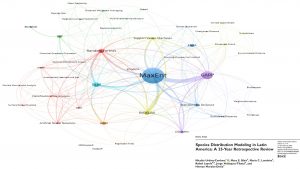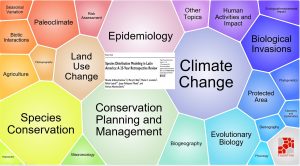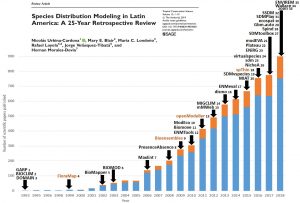
Species distribution modeling (SDM) is a booming area of research that has had an exponential increase in use and development in recent years. We performed a search of scientific literature and found 5,533 documents published from 1993 to 2018 using SDM, representing a global network of 4,329 collaborating institutions from 155 countries, with Brazil and
Mexico being in the top 10 of the most prolific countries globally. National Autonomous University of Mexico, Chinese Academy of Sciences, University of Kansas, and U.S. Geological Survey are the most prolific institutions worldwide. Latin American institutions (n¼556) participated in 1,000 (18% of global productivity) documents published in collaboration with 591 institutions outside Latin American countries, from which the National Autonomous University of Mexico, Federal University of Goia´s, Institute of Ecology A.C., National Scientific and Technical Research Council in Argentina, University of Sao Paulo, and University of Brasilia were the most productive.

From this body of literature, the most frequently modeled taxonomic groups were Chordata and Insecta, and the most common realms of application were conservation planning and management, climate change, species conservation, epidemiology, evolutionary biology, and biological invasions. From the 36 modeling methods identified to generate SDMs, MaxEnt is used in 73.5% of the papers, followed by Genetic Algorithm for Rule-Set Prediction (GARP) with 18.7%, and just 7.4% of the papers compared between 3 and 10 modeling methods.
In Latin American countries, productivity in SDM research could be improved as the network of collaborations diversifies and connects with other productive countries (such as United Kingdom, China, Spain, Germany, Australia, and France).

The scientific collaboration between Latin American countries should be increased, as the most prolific countries (Brazil, Mexico, Argentina, and Colombia) share less than 10% of its productivity. Some of the main challenges for SDM development in Latin America include bridging the gaps from (a) software use to research productivity and (b) translation to decision-making.
To address these challenges, we propose to strengthen communities of practice where modelers, species experts, and decisionmakers come together to discuss and develop SDM to shift and enhance current paradigms on how science and decisionmaking are linked.
DOI: https://doi.org/10.1177/1940082919854058
